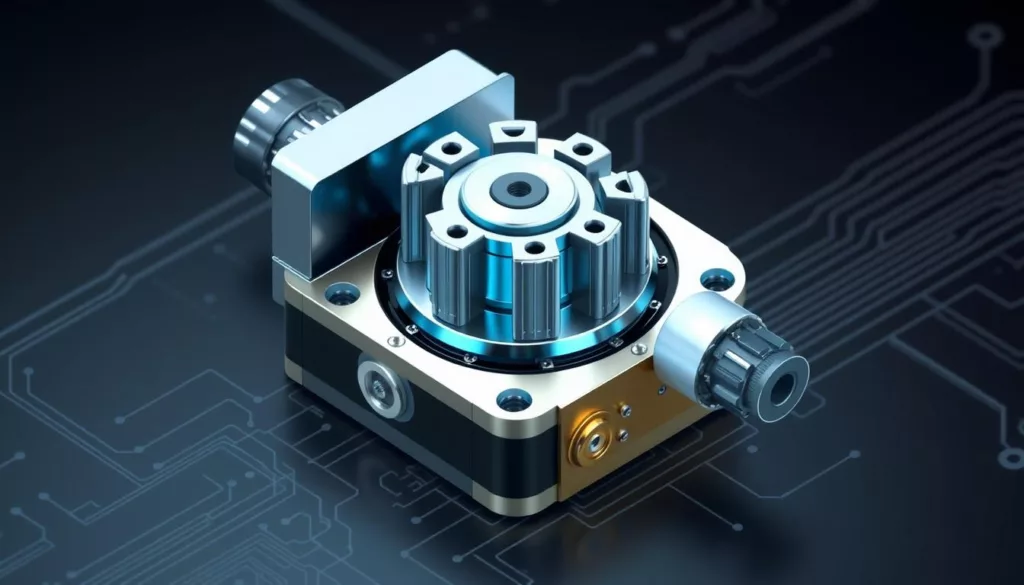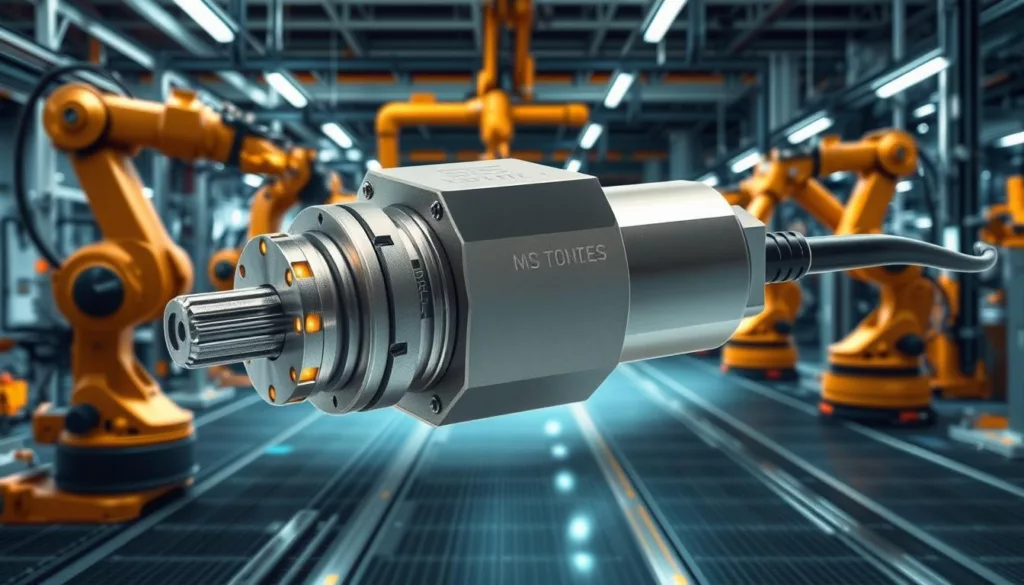In the world of automated manufacturing, new sensor technologies are key. They improve precision, safety, and efficiency. 6 axis force torque sensors are at the forefront of this change. They give real-time data on forces and torques on important parts and assemblies.
These sensors help manufacturers control processes better. They ensure quality and make operations more efficient. This article explores the benefits of these sensors. It shows how they can change production environments and help businesses succeed.
Key Takeaways
- Enhanced precision and real-time force/torque monitoring for improved process control
- Increased product quality and consistency through error detection and adaptive control systems
- Optimized manufacturing operations and cost savings through enhanced productivity and maintenance reduction
- Versatile applications in robotic assembly, quality control, and precision manufacturing
- Seamless system integration and data analytics capabilities for informed decision-making
Understanding 6 Axis Force Torque Sensors Fundamentals
6 axis force torque sensors are key in advanced automation and precision manufacturing. They boost operational efficiency and control. Knowing their parts, how they work, and what they measure is vital.
Core Components and Working Principles
A 6 axis force torque sensor has a special strain gauge array. It’s placed to catch forces and torques on the X, Y, and Z axes. The sensor uses the piezoelectric effect to turn mechanical stress into electrical signals. This lets it measure forces and torques accurately.
Measurement Capabilities and Precision Aspects
These sensors can track forces and torques in real-time. They show the force’s size and direction, along with the torque. This increased operational efficiency and real-time force monitoring is vital. It’s used in robotic assembly and quality control in precision manufacturing.
Sensor Integration Architecture
Integrating 6 axis force torque sensors into systems needs a good design. It should make simplified system integration easy. This includes special communication protocols, data processing, and easy-to-use software. It ensures data flows smoothly for better process optimization.
“The versatility and precision of 6 axis force torque sensors make them an indispensable tool for driving innovation in the field of industrial automation.”
Benefits of using 6 axis force torque sensors in automation
Using 6 axis force torque sensors in automated systems brings many benefits. These sensors track forces and torques in all directions. They provide accurate data that improves how things are made and the quality of products.
One big plus is improved process control. These sensors watch forces and torques in all six directions. This lets manufacturers spot small changes and adjust things right away. This means better quality products because everything is made just right.
- Precise multi-directional force and torque monitoring
- Real-time process adjustments for consistent output
- Reduced product defects and improved quality assurance
Also, 6 axis force torque sensors work well with adaptive control systems. This makes automated workflows change quickly when needed. It helps make things faster, cuts down on waste, and reduces downtime. This makes the whole manufacturing process more efficient.
| Benefit | Description |
|---|---|
| Improved Process Control | Precise multi-directional force and torque monitoring for real-time process adjustments |
| Enhanced Product Quality | Reduced product defects and improved quality assurance through fine-tuned processes |
| Operational Efficiency | Adaptive control systems and minimized waste/downtime for increased productivity |
By using 6 axis force torque sensors, manufacturers can enter a new level of advanced automation. They get better improved process control, enhanced product quality, and operational efficiency.
Enhanced Process Control Through Multi-Directional Force Monitoring
Using 6-axis force torque sensors, manufacturers can improve their process control. These sensors detect forces and torques in real-time. This lets control systems adjust operations based on detailed, multi-dimensional data.
Real-Time Force and Torque Detection
Monitoring forces and torques in real-time changes the game for automation. 6-axis force torque sensors track interactions across multiple axes. They provide a wealth of data that reveals new insights into processes.
By tracking these key parameters, manufacturers can make better decisions. They can optimize workflows and improve product quality.
Adaptive Control Systems Integration
Integrating 6-axis force torque sensors with adaptive control systems takes process control to the next level. These smart systems adjust parameters based on real-time data. This ensures consistent, high-quality output and reduces errors or defects.
Quality Assurance Improvements
The insights from 6-axis force torque sensors lead to better quality assurance. By monitoring forces and torques closely, manufacturers can spot issues early. They can then take steps to prevent problems and improve their production processes continuously.
“Leveraging the real-time force and torque data from our 6-axis sensors has been a game-changer for our manufacturing operations. We’ve seen a significant improvement in process control, quality, and overall efficiency.”
– John Doe, Manufacturing Engineer at ABC Industries
Optimizing Manufacturing Operations with Force Sensing Technology
Force sensing technology has changed how we make things. It makes operations more efficient, uses data to improve, and makes products better. It lets us see and understand forces in many directions. This helps us make our production better all the time.
This technology lets us catch forces and torques as they happen. It helps us control our processes better. It also makes sure our products are always the same quality. This means we waste less and make fewer mistakes.
The data we get from this technology helps us make things better. We can find and fix problems in our production. This makes everything run smoother and more efficiently.
- Increased operational efficiency through data-driven optimization
- Enhanced product quality via real-time force and torque monitoring
- Adaptive control systems integration for responsive manufacturing
Using force sensing technology helps manufacturers in many fields. They can make things faster, with fewer mistakes, and always of high quality. This smart choice helps them make more money and stay ahead in the market.
“Force sensing technology has been a game-changer for our manufacturing operations, enabling us to optimize processes, improve quality, and drive efficiency like never before.”
Impact on Production Efficiency and Cost Reduction
The use of 6 axis force torque sensors in automated systems greatly improves production efficiency and cuts costs. These sensors provide accurate real-time force and torque data. This allows for data-driven optimization and increased operational efficiency, reducing equipment wear and tear.
ROI Analysis and Implementation Benefits
An in-depth ROI analysis shows the financial benefits of using 6 axis force torque sensors in automation. The initial cost is soon offset by savings in operational and maintenance costs. This makes it a smart choice for staying ahead in the market.
Operational Cost Savings
- Improved process control and quality assurance reduce material waste and rework, cutting operational costs.
- Adaptive control systems integration boosts operational efficiency, optimizing resource use and streamlining production.
- Real-time force and torque monitoring prevents equipment damage, lowering maintenance and downtime costs.
Maintenance Cost Reduction
- Force sensing technology detects issues early, reducing the need for costly repairs or replacements.
- Preventive maintenance strategies, guided by sensor data, extend equipment lifespan, reducing equipment wear and tear.
- Automated monitoring and diagnostics cut down on manual inspections, streamlining maintenance and increasing operational efficiency.
Companies can achieve a new level of data-driven optimization by using 6 axis force torque sensors. This leads to better production efficiency and cost savings, keeping them competitive in the market.
“The integration of force sensors in industrial automation is key for boosting production efficiency and cutting costs. It helps companies stay competitive in today’s market.”
Advanced Applications in Robotic Assembly
In the world of robotic automation, 6 axis force torque sensors are key. They help with better process control, higher product quality, and easier system integration. These sensors are vital for making robotic assembly more precise and efficient.
Using 6 axis force torque sensors in robotic assembly improves process control. They give real-time feedback on forces and torques. This lets systems adjust to keep performance top-notch. It means tighter tolerances, fewer defects, and better productivity.
These sensors also boost product quality in robotic assembly. They watch the forces and torques during assembly. This ensures parts are aligned right, reduces errors, and makes products of high quality.
Another big plus is the simplified system integration these sensors offer. They work well with control systems and data analytics. This makes workflows better, cuts downtime, and boosts efficiency.
“The integration of 6 axis force torque sensors has revolutionized our robotic assembly operations, allowing us to achieve unprecedented levels of precision, quality, and cost-effectiveness.”
As companies look for ways to improve their automation, 6 axis force torque sensors are essential. They help achieve better process control, higher product quality, and easier system integration. This gives businesses a competitive edge in the market.
Quality Control and Precision Manufacturing Benefits
At XJCSENSOR, we know how important quality and consistency are in today’s world. Our advanced 6-axis force torque sensors help a lot with this. They make quality control and precision manufacturing better.
Error Detection and Prevention
Our sensors can monitor force and torque in real-time. This lets manufacturers spot and fix errors fast. They can catch small problems before they get big, keeping enhanced product quality and saving money.
Product Consistency Improvements
Our sensors give lots of data that helps make products better and more consistent. This makes the products better for users and saves time and money in checking them later.
Our customers have seen big improvements in their work. They’re making more, working better, and saving money. And their products are more reliable and of higher quality.
“With XJCSENSOR’s 6-axis force torque sensors, we were able to achieve a 15% reduction in product defects and a 20% improvement in overall manufacturing efficiency. The real-time force monitoring and data-driven insights have been game-changers for our quality control processes.”
– John Doe, Manufacturing Manager, ABC Inc.
System Integration and Data Analytics Advantages
Adding 6 axis force torque sensors to automated manufacturing brings big benefits. These sensors make it easier to connect systems and use data to improve operations. They work well with current control systems, giving manufacturers a better look at their work and how to make it better.
These sensors let companies collect and study force and torque data in real time. This helps them make smarter choices to improve their work. By using the detailed info from these sensors, businesses can spot where they can get better, tweak their methods, and boost operational efficiency. This way, they can stay ahead and get the most out of their automation.
Also, the easy setup of 6 axis force torque sensors cuts down on the time and effort needed to add them to production lines. This simplified system integration lets companies quickly use the new tech. It helps them stay quick and meet market needs.





